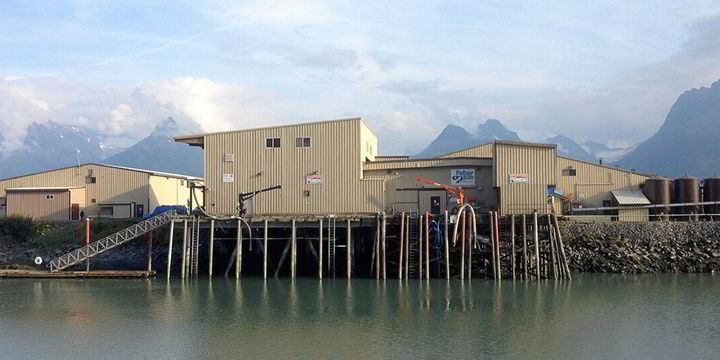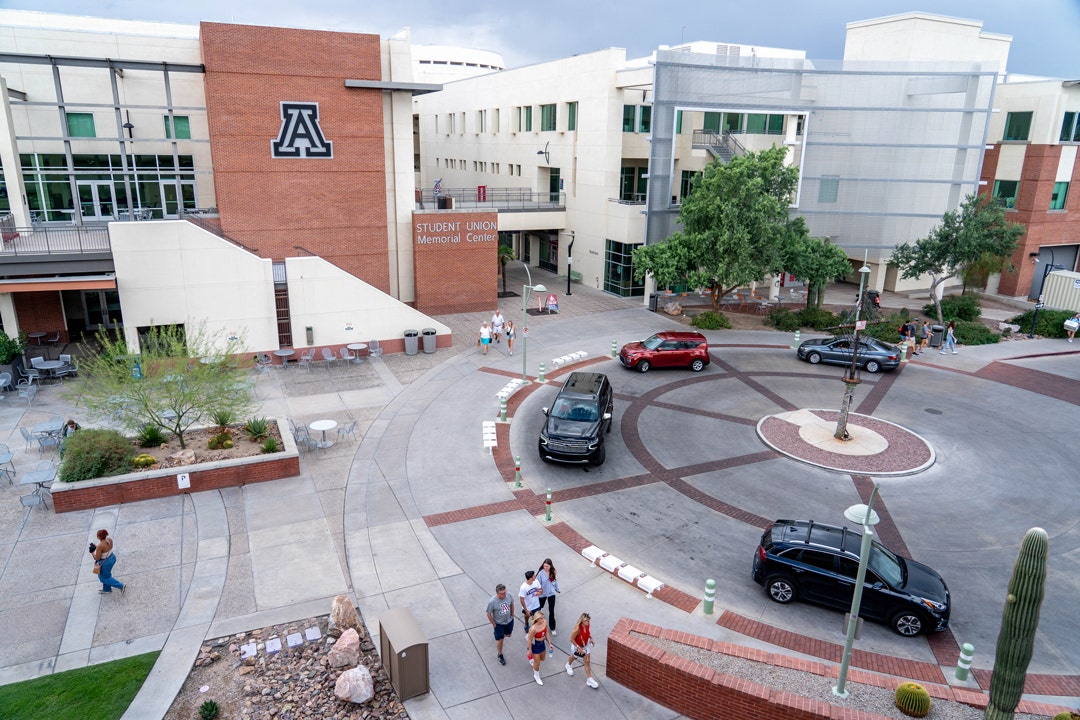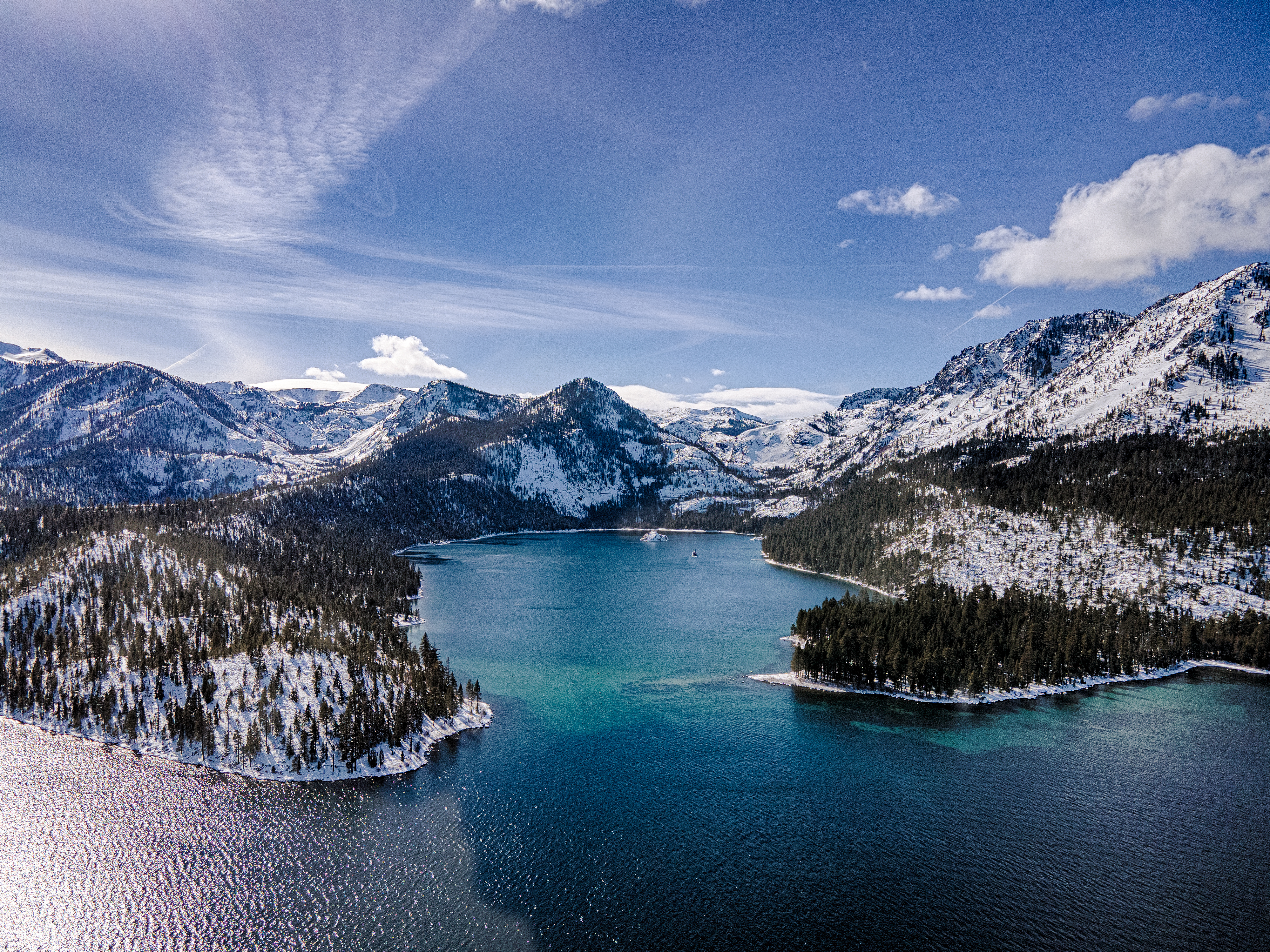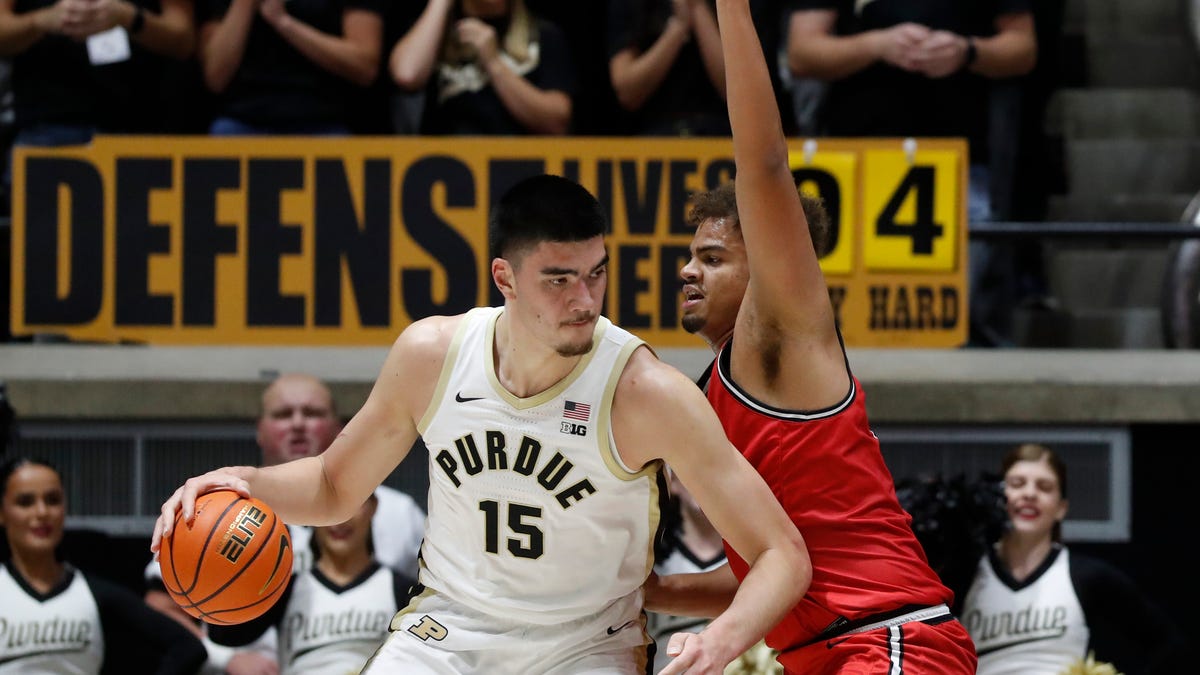Lifestyle
This iconic wildflower spot can be dazzling. Is it worth the 150-mile trek from L.A. this year?
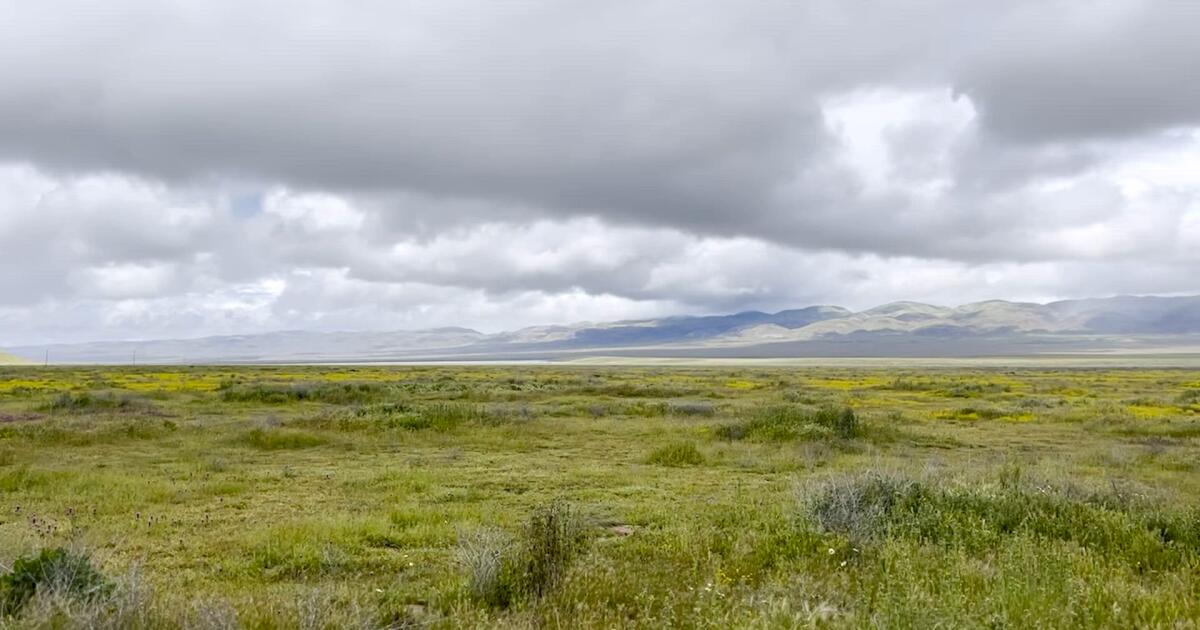
Carrizo Plain National Monument in eastern San Luis Obispo County is one of California’s most iconic wildflower viewing areas, but is this year’s display worth the 150-mile drive from L.A.?
If you’re looking for blankets of bright color covering the hills, the answer is no.
But if you want a beautiful outing with boundless sky, close encounters with birds, Indigenous and geologic history and undulating waves of grass punctuated by splotches of gold, violet and orange, then definitely yes — but wait a good week or more for the muddy roads to become passable again.
In early March, a friend and I planned our visit for April 14, largely because the rainy season is typically over by the end of March, peak bloom is typically in early April, and given this spring’s cool temperatures, we figured the weather would have warmed by then to encourage a good display. But the first two weeks of April brought plenty of chilly showers to much of Central and Southern California, and during our visit, the temperatures hovered in the mid-50s, and the rain waxed and waned between hopeful moments of blue sky followed by black clouds and water falling in curtains.
The best wildflower display was in a large photo from 2019 of goldfields carpeting a valley hanging in the bathroom of the Cuyama Buckhorn restaurant in New Cuyama.
(Jeanette Marantos / Los Angeles Times)
Truth be told, the best wildflower display we saw during our visit was a 2019 photograph in the restroom of the Cuyama Buckhorn restaurant in New Cuyama — a stunning view of California goldfields (Lasthenia californica) growing so vast in the Carrizo Plain during a superbloom that they looked like a golden carpet stretching for miles.
Truth be told, the best wildflower display we saw during our visit was a 2019 photograph in the restroom of the Cuyama Buckhorn restaurant.
We did see swaths of goldfields during our soggy trip, along with armies of brown sodden tumbleweeds and pockets of other wildflowers, such as purple owl’s clover (Castilleja exserta), which are actually violet; yellow and white common tidy tips (Layia platyglossa); and (rarely) California poppy (Eschscholzia californica). But the most prominent color was the bright green of California’s hills after a rainy spring.
The tall grass was thick and ripply, like wind on water, and often erupted with birds that flew alongside our car and sometimes outpaced us because Soda Lake Road, the lone paved road, was pocked with gaping potholes and puddles of concerning depth.
A superbloom? Not then and probably not this year, according to the rangers at the Goodwin Education Center at Carrizo Plain. The sign behind the front counter told the story. The last three superbloom years — when wildflowers bloomed so densely that they formed quilts of color over the hills — were in 2017, 2019 and 2023, the rangers said, when the region’s rainfall from Oct. 1 to Sept. 30 had, respectively, been 12.29 inches, 16.31 inches and 15.32 inches. So far, the rainfall for 2024’s water year is less than 10 inches — including the unseasonable rain falling April 14 — and more rain this season is not expected.
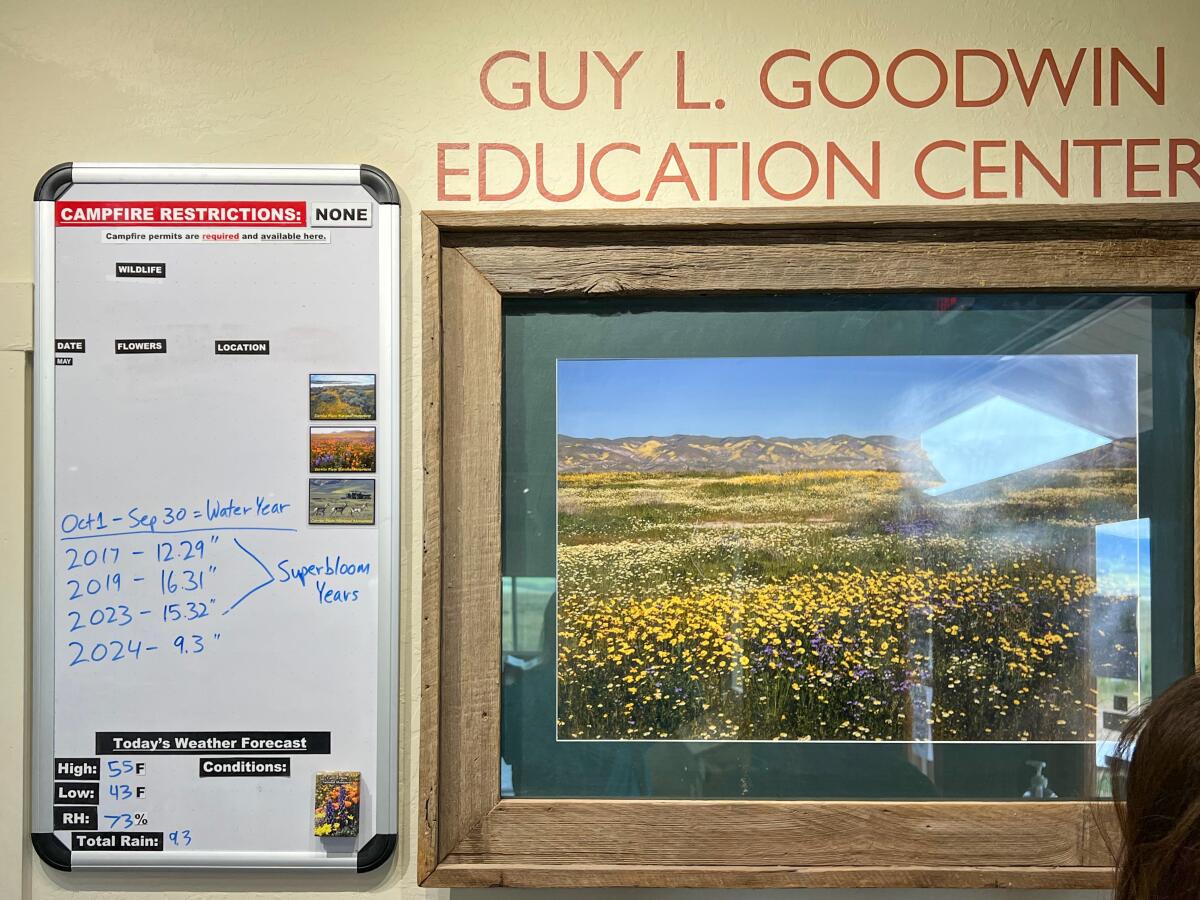
The sign in the Guy L. Goodwin Education Center shows that the Carrizo Plain’s rainfall this year has been less than in past years with “superblooms” that carpeted the hills.
(Jeanette Marantos / Los Angeles Times)
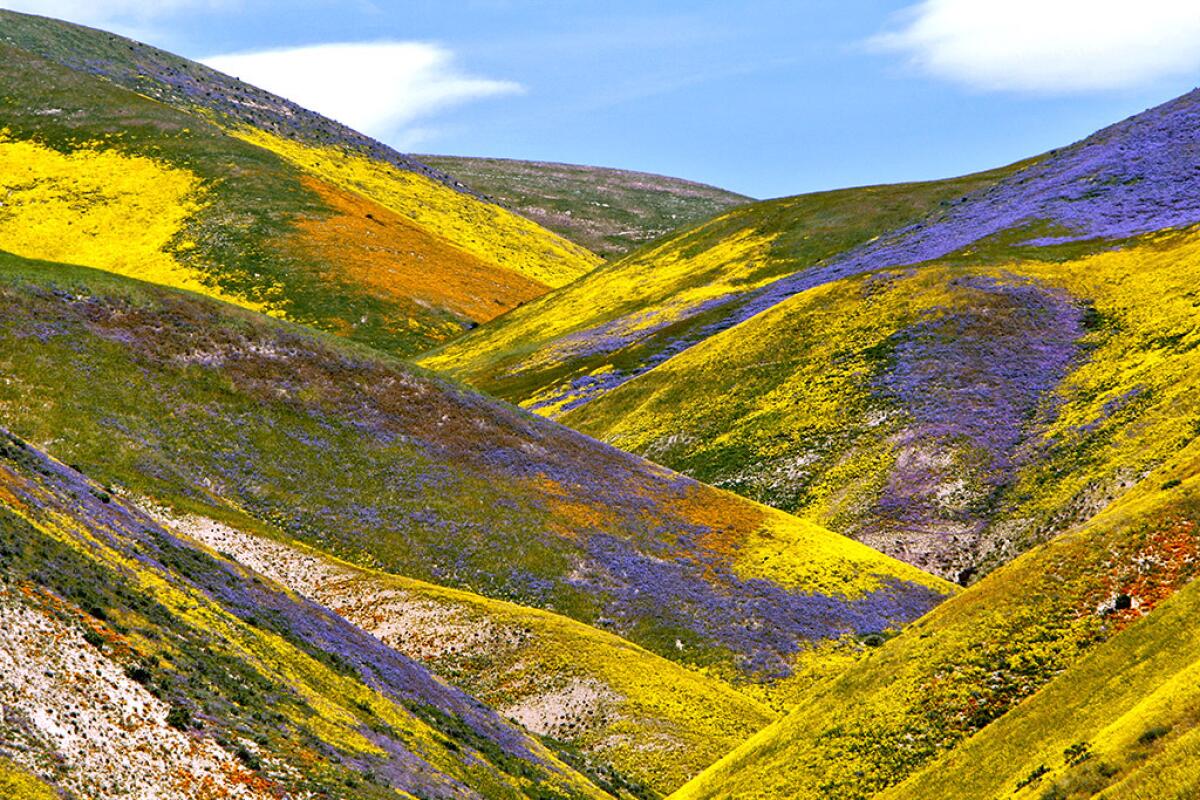
The Carrizo Plain superbloom on April 16, 2017.
(Raul Roa / Los Angeles Times)

Scenes of the Carrizo Plain on April 14, 2024 during a drive on the paved portion of Soda Lake Road in Carrizo Plain National Monument in San Luis Obispo County. These days, the plain consists primarily of grasses, with sporadic color.
(Jeanette Marantos / Los Angeles Times)
The Carrizo Plain stretches 50 miles between the Temblor and Caliente mountains, a grassy plain and drainage basin where Chumash, Yokuts and other Indigenous peoples hunted and traded before settlers tried their hand at dryland farming. There are a few campgrounds, trails and unpaved roads, but no services (such as gas, water, food and, usually, cell). The temperatures often exceed 100 degrees in the summer and dip down to freezing during the winter, according to the brochure. All but one of the roads, Soda Lake Road off Highway 58, are unpaved, and even Soda Lake Road becomes an unpaved, rutted road five miles south of the Goodwin Education Center, which features restrooms and picnic tables, along with books, gifts and exhibits.
Besides birding, camping, hiking and wildflower peeping, you can walk along the San Andreas Fault on the Wallace Creek trail, wander on a platform trail along Soda Lake, which becomes a “dry, salt-encrusted basin during the dry season,” according to the brochure, and study the pictographs left by Native peoples on Painted Rock, which this time of year can be visited only with ranger guides on Saturdays (reservations required).
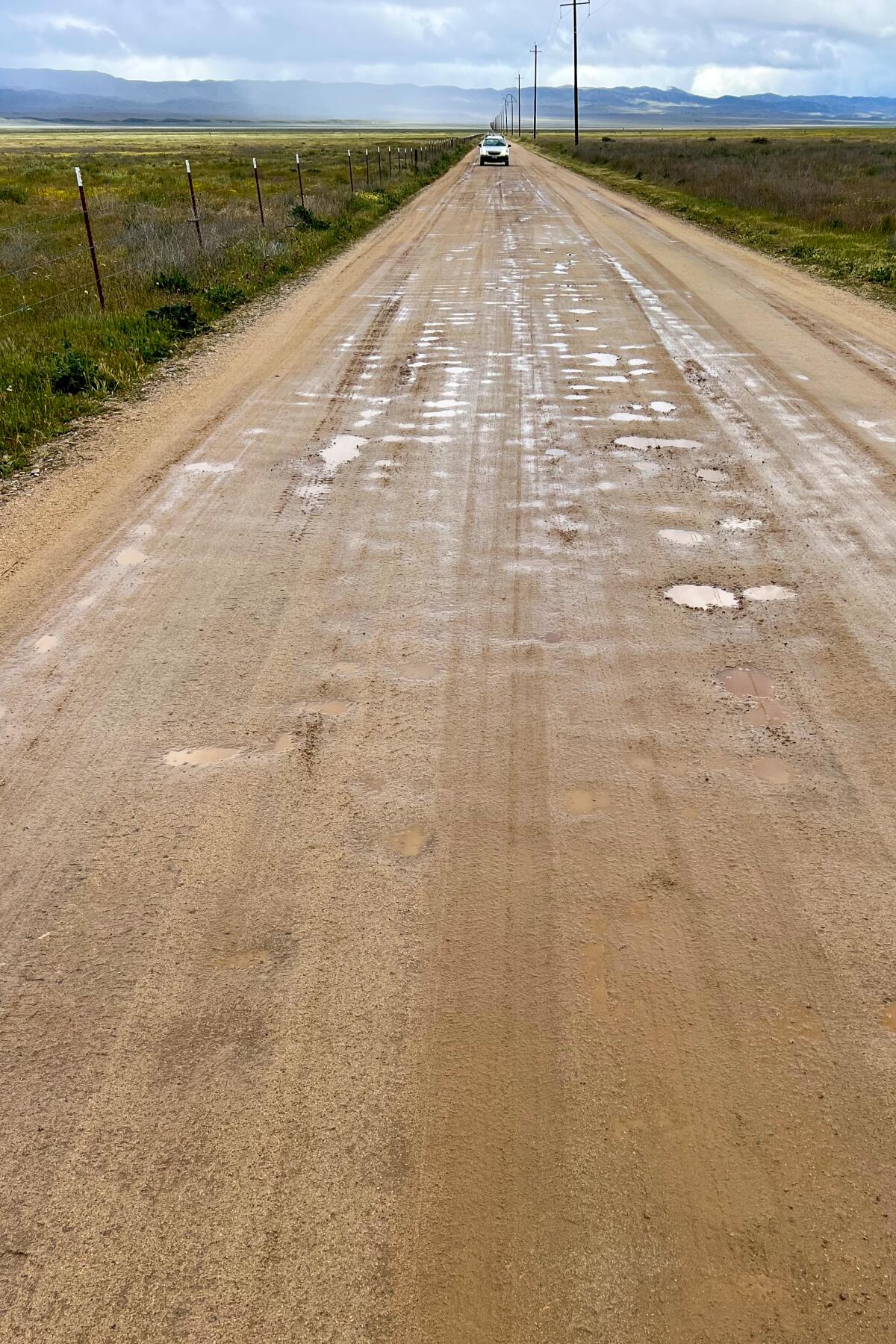
It poured rain much of the day, and the nonpaved roads were mostly impassable, except for a short road to the visitor center.
(Jeanette Marantos / Los Angeles Times)
But on Sunday, we couldn’t do any of that because the muddy, unpaved roads were so impassable that even tow trucks were getting stuck, according to rangers. Every few minutes, someone came into the center and asked the same question — is it safe to keep driving south on Soda Lake Road once the pavement ends? And every time, the rangers patiently answered that they definitely wouldn’t recommend any of the unpaved roads for two-wheel-drive cars, or even four-wheel-drive SUVs, unless they had high clearance, nerves of steel and enough money to pay for a tow truck.
The few that braved the back roads drove brawny vehicles that looked like they’d been sloppily dipped into chocolate. As my friend and I wavered about what to do, we spoke with two people who had made the drive. They had a kind of hysterical look and emphatically told us not to try, even though my Toyota Highlander SUV has four-wheel drive. “I can’t believe we made it,” said one wide-eyed woman in a large pickup with mud caked halfway up its windshield. “You’d never get through.”
A few hearty souls were walking in the rain on the platform trail along Soda Lake, but the tiny parking area had so many muddy ruts and puddles that we decided to avoid that too, lest we get stuck. Instead, I grumpily drove back north to California 58 — even though I hate backtracking — and headed east. Our mood quickly improved along this spectacular winding drive through what looked like the verdant, tree-dappled Shire in the Lord of the Rings.
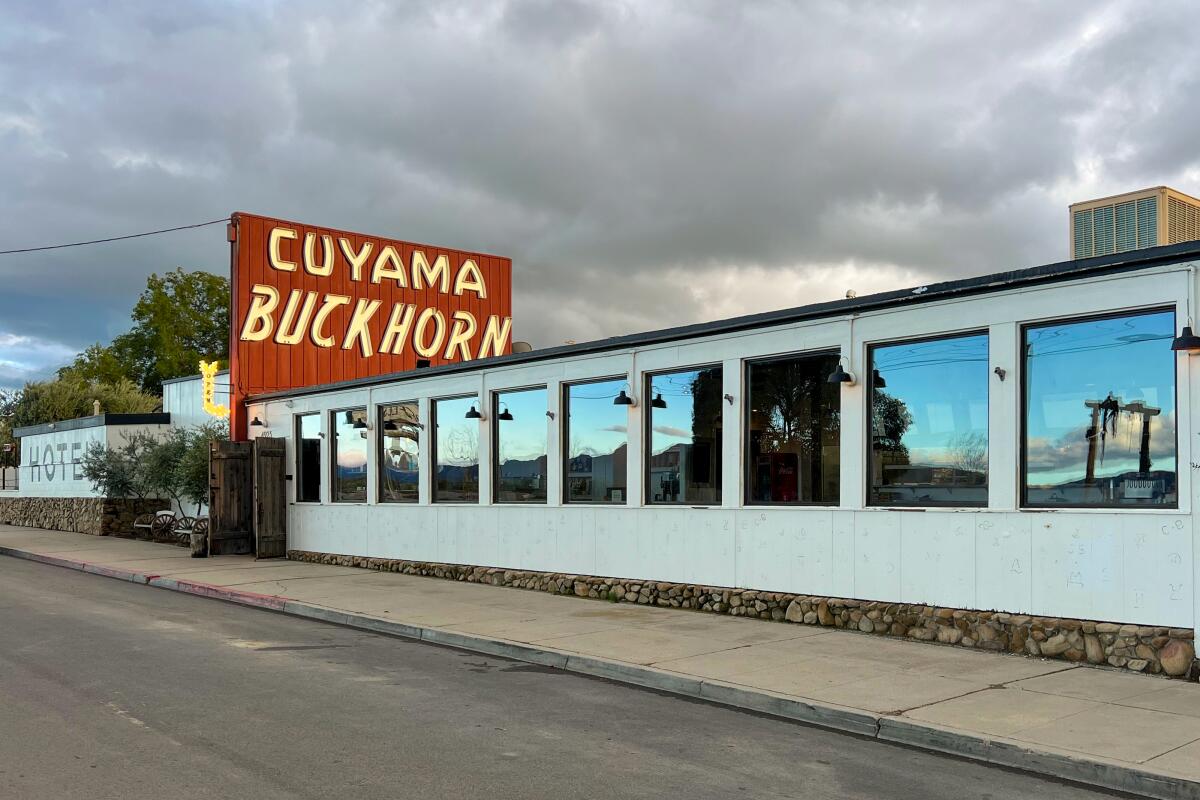
The Cuyama Buckhorn restaurant in New Cuyama. Order the smoked oyster mushroom tacos and check out the bathroom for a gorgeous 2019 superbloom photo.
(Jeanette Marantos / Los Angeles Times)
After our lovely drive south on 58, we turned west on California 33 near McKittrick, and within a few miles entered a hellscape of bobbing oil pumps and acres of power poles and wires between Derby Acres and Taft. Our destination was New Cuyama for a late lunch-early dinner at the Cuyama Buckhorn restaurant on California 166, which runs along the western border of the Carrizo Plain. I heartily recommend this restaurant, which despite its tiny town locale has a sophisticated, upscale bar, wine list and menu (the smoked oyster mushroom tacos with tender blue-corn tortillas — made at the restaurant — are to die for), along with a remodeled hotel.
And when we were done, the clouds were parting, luckily, because our final leg took us west through Los Padres National Forest on California 33, a scenic but winding road where earlier rain had washed out several spots, so we had to stop frequently to wait for a green light to travel along single lanes. The going was beautiful but slow and a little hair-raising as day turned to night.

Lifestyle
As National Poetry Month comes to a close, 2 new retrospectives to savor

W. W. Norton & Company, Alice James Books

W. W. Norton & Company, Alice James Books
With National Poetry Month comes spring flowers and some of the year’s biggest poetry publications. And as April wraps up, we wanted to bring you two of our favorites — retrospective collections from two of the best poets of the late 20th and early 21st centuries: Marie Howe and Jean Valentine.
Howe’s New and Selected Poems makes a concise case for Howe’s status as an essential poet. The New & Collected Poems of Jean Valentine gathers all of the beloved late poet’s work, a monument to a treasured career.
New and Selected Poems by Marie Howe
Marie Howe is writing some of the most devastating and devastatingly true poems of her career — and some of the best being written by anyone. Her subject matter, from a bird’s eye, is simply the big questions and their non-answers: What are we here for? What does it mean to do good? What have we done to the environment? What are the consequences and what do we who are here now owe to those who will follow us? And yet her tone and straightforward delivery make her poems as approachable as friends. Howe is the rare poet whose poems one wants to hug closely for company, companionship, and empathy; and yet they are works of literature of the highest order, layered, full of booby traps and shoots and ladders that suddenly transport one between the words. It’s tough love that these poems offer, but it’s undeniably love.
This first retrospective gathers a book’s worth of new poems along with ample selections from of Howe’s four previous collections, each of which was a landmark when it was published. Her nearest antecedent might be Elizabeth Bishop, who also didn’t write very much, or didn’t publish very much, but everything she wrote was good if not capitol-G-Great. Howe is best know for What the Living Do (1997), which remains one of the great books on youth and grief, regret, and moving forward if not moving on. It regards a world in which “anything I’ve ever tried to keep by force I lost.” Startling, almost koan-like statements like this erupt out of unassuming domestic scenes, making everyday life into high drama.
The typical speaker of a Howe poem is a woman who seems much like Marie Howe, even when she is speaking through the voice of the biblical Mary, as she does in Magdalene (2017): “I was driven toward desire by desire.” She is serious except when she’s funny, though she’s rarely laugh out loud funny — it’s more of a kind of internal laughter, either like blossoming light or paper rustling in one’s chest. She is consoling, except when she is taking herself and readers to task, bowing under the simple, Herculean responsibilities that come with living a life, being a parent. She’s tough, sometimes even stoic, except that in almost every poem there is a moment of surprise, a revelation, a piercing insight that injects a kind of pure ecstasy.
Some of the new poems are among the best Howe has written, making them among the best period. Set “In the middle of my life — just past the middle,” these poems grieve lost friends; reckon with the sudden adulthood of a daughter; lament the destruction of the environment; and take the moral measure of this very disturbing era. Each of these everyday dramas becomes an access point for the deepest kind of human reconciliation, where we must finally admit where language fails us. These poems also feature a recurring character, “our little dog Jack,” who, with all best intentions, becomes one of Howe’s most devastating metaphors. But all metaphors have their root in plain fact. As Howe writes in “Reincarnation,” one of her best poems, “Jack may be actually himself — a dog.”
Light Me Down: The New and Collected Poems of Jean Valentine
This is one of those monumental events in American poetry: the life’s work of a major poet gathered in one big book, an opportunity to revel in all that Jean Valentine accomplished in her long and prolific career. As a young poet, Valentine (1934-2020) won the Yale Series of Younger Poets prize in 1965, for her debut collection, Dream Barker. In 2004, she won the National Book Award for Door in the Mountain: New and Collected Poems 1965-2003. In between, and after, she was always well regarded by the mainstream poetry establishment, winning most of the prizes available to an American poet.
But Valentine’s real influence was as a friendly ambassador to and from the avant-garde. It’s hard to pin Valentine’s poems down: I wouldn’t call them experimental, but they are anything but straightforward in their slippages of thought and wide leaps of association. Fairly early in her career, Valentine begin working in a style that had her teasing the reader with images, gently suggesting the way the poem should go, until, perhaps, a thunderclap at the end disturbs the calm. She always knows where to end. Pick almost any poem and the last couple of lines will shock you with their unlikely inevitability.
Valentine writes about everything — love, death, sex, the roiling political situations of the last half-century — with simultaneous candor and mystery: “I have been so far, so deep, so cold, so much,” she says prophetically in an early poem. She asserts that poetry can be made almost entirely through suggestion, that the poet must trust the secret links between one word and another, and trust that the reader will be willing to travel with the poet along those underground currents. In a short poem, a haiku from 1992, “To the Memory of David Kalstone,” dedicated to the literary critic who died in 1986, Valentine offers as succinct a statement of her poetics as one could want: “Here’s the letter I wrote,/ and the ghost letter, underneath—/ that’s my life’s work.” Valentine’s poems draw our attention to the words beneath the words, what’s said between them, in all the white space surrounding the poems.
Elsewhere Valentine opts for simple observations, stirred by a bit of mystery, as in the brief elegy “Rodney Dying (3)”:
“I vacuumed your bedroom
one gray sock
got sucked up it was gone
sock you wore on your warm foot,
walked places in, turned,
walked back
too off your heavy shoes and socks
and swam”
There are no sudden bolts of profundity here, nothing, really, that you could call insight, at least not overtly. Instead, Valentine asks an object, the sock, to carry the grief. This is a technique poets call the “objective correlative” — it’s an image that stands in for an emotion or knot of emotions. That unassuming object, or really just the word for it — sock — becomes a vessel, a kind of canopic jar to contain grief, but also to let it rattle around a bit. The poem ends with what might be an allegory for death, but is also a celebration of Rodney’s vitality. The language is as plain as can be, and yet I exit the poem with uncertainty, equally hopeful and despairing. Valentine is an expert at tensing these sorts of contradictions against one another. The emotional climate in Valentine’s poems is ambivalent in the best way, lit by contradictory energies.
And while this book is a monumental celebration of an extraordinary legacy, it is also sad to hold: Valentine was in an inexhaustible and generous force in American poetry until so recently. It feels impossible to accept the fact that she is dead while reading poems that are so profoundly alive.
Craig Morgan Teicher is the author of several books, including The Trembling Answers, which won the 2018 Lenore Marshall Poetry Prize from the Academy of American Poets, and the essay collection We Begin in Gladness: How Poets Progress.
Lifestyle
Mike Myers Debuts White Hair in First Public Appearance in Over a Year

Mike Myers returned to the spotlight for a rare public appearance this weekend … but folks had to do a double take, ’cause nobody could recognize him with his new hair color.
The actor stepped out Saturday for the 49th AFI Life Achievement Award Gala in L.A. — where Nicole Kidman was being honored — which marked his first time at a public event in about a year.
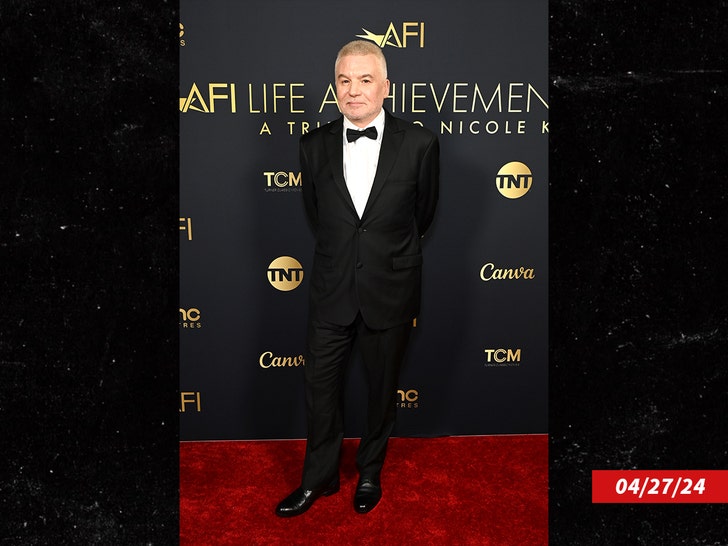
Mike looked unrecognizable with short white hair — but was rocking it proudly as he spoke onstage at one point … and posing for tons of pics before heading inside, all smiles.
He was even taking photos with fans too … acting goofy and posing for a bunch of selfies.
Mike has always kept a relatively low profile … as he and his wife, Kelly Tisdale, are known for keeping their home life super private. So, seeing MM out and about like this is pretty remarkable — especially since he’s a silver fox now, and totally leaning into it.
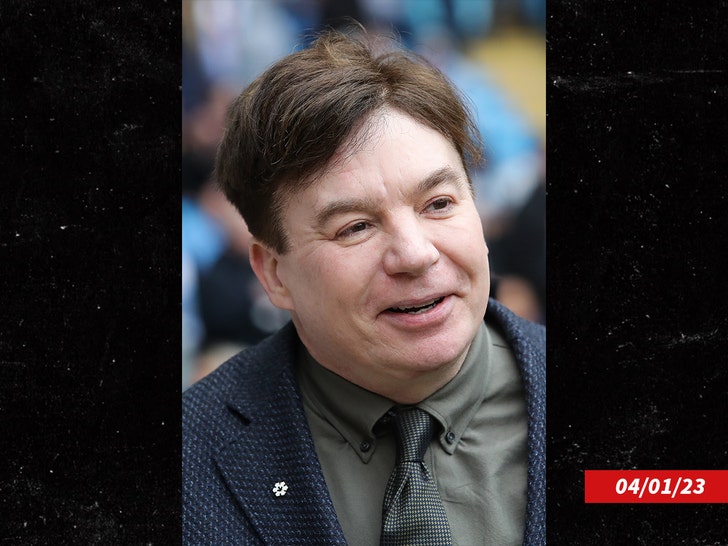
The last few times Mike was out in public was in April and May of 2023 — in April of that year, his was quite a bit longer … and more importantly, it was the same color of brown we’ve seen him in for years now.

In May, the guy was at a basketball game — with pretty damn good seats, it seems — but there … he was wearing a beanie, covering up his ‘do. Since then, he’s been kinda MIA.
Anyway, it was clearly a big enough occasion to get Mike out of the house and into the public eye again — remember, this was all about Nicole … and anyone who’s anyone showed up to give her her flowers, including a ton of celebs.
Among the stars in attendance … Reese Witherspoon, Joey King, Michelle Pfeiffer, Jane Seymour, Miles Teller, Naomi Watts, Morgan Freeman and lots of others.
Mike certainly stood out though … and we gotta say, he’s looking real sharp these days!
Lifestyle
In 'Dead Boy Detectives,' two best mates reject their deadly fates : Pop Culture Happy Hour

-

 Kentucky1 week ago
Kentucky1 week agoKentucky first lady visits Fort Knox schools in honor of Month of the Military Child
-

 News1 week ago
News1 week agoIs this fictitious civil war closer to reality than we think? : Consider This from NPR
-

 World1 week ago
World1 week agoShipping firms plead for UN help amid escalating Middle East conflict
-

 Politics1 week ago
Politics1 week agoICE chief says this foreign adversary isn’t taking back its illegal immigrants
-

 Politics1 week ago
Politics1 week ago'Nothing more backwards' than US funding Ukraine border security but not our own, conservatives say
-

 News1 week ago
News1 week agoThe San Francisco Zoo will receive a pair of pandas from China
-

 World1 week ago
World1 week agoTwo Mexican mayoral contenders found dead on same day
-

 Politics1 week ago
Politics1 week agoRepublican aims to break decades long Senate election losing streak in this blue state
